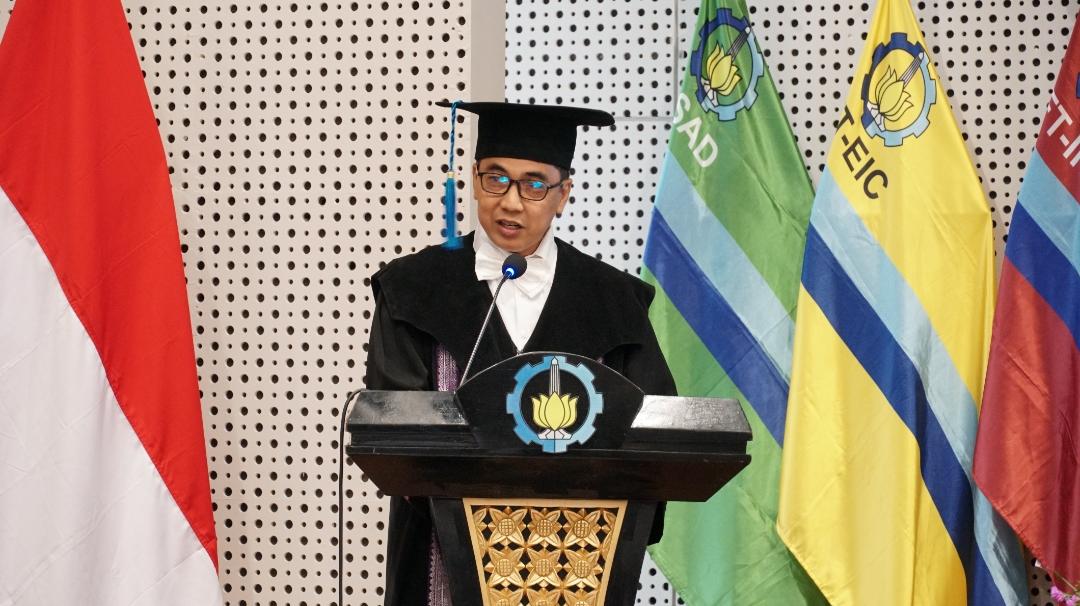ITS Professor Devises Method to Improve Antenna Technology Performance

ITS’s 210th professor Prof. Eko Setijadi ST MT PhD in the field of Antenna and Propagation Technology when delivering his scientific oration at the inaugural session of professor
ITS Campus, ITS News — Small devices are one of the innovations that can support the efficiency of human mobility. However, if this is applied to antenna technology, it causes antenna performance that tends to decrease. This is what prompted the 210th Professor of the Institut Teknologi Sepuluh Nopember (ITS) to create a method to improve the performance of antenna technology in a compact device size.
Prof. Eko Setijadi ST MT PhD explained that antenna technology is a technology to convert electrical signals from cables into electromagnetic waves that can propagate in the air. Generally, the technology is used in telecommunication, radar, navigation, and radio devices. “To improve the connectivity of these devices, it is necessary to improve the performance of antenna technology,” Eko explained.
The professor from the Department of Electrical Engineering ITS added that the performance in question is the demand to be able to provide 5G, 6G internet networks, to make it an implantable device in the medical field. Therefore, antenna technology development methods were innovated in terms of gain, bandwidth, and both to provide maximum performance with a compact size.
Furthermore, the man who graduated from Kumamoto University, Japan, explained that the gain in antenna technology functions as an amplification of the input signal for its output. This is done by providing a slot on the metal surface. It is then connected to the power between two antennas that have combined rings on the antenna resonator. “With this method, the gain increase reaches up to 14 dB operating at a frequency of 26 GHz,” he said.

Prof. Eko Setijadi ST MT PhD shows the miniature antenna that he initiated to improve the 5G internet network in the room.
Not only that, the lecturer from the Multimedia Network and Telecommunications Laboratory, Department of Electrical Engineering ITS also developed the frequency range of signal propagation so that the antenna can operate effectively. The innovation, called bandwidth development, was carried out by Eko by adding a U slot structure to the metal surface. “If the main slot is connected to power, the U slot is able to widen the signal frequency nine times or equivalent to 1.2 GHz,” explained the man born on October 1, 1972.
With these satisfactory results, Eko combined his two innovations simultaneously to have a more significant impact. He did this by adding a periodic structure or mematerial (MM) to give an indication of the negative refractive index in the material. “This method is able to widen the bandwidth to 1.79 GHz with a gain increase of up to 15 dB,” said the man from Sidoarjo.

Prof. Eko Setijadi ST MT PhD (two from right) with family after ITS Professor Inauguration Session
With his three methods, Eko then implemented them in the form of a miniature antenna measuring 3 x 4 centimeters. According to Eko, the antenna that he managed to form with a compact size and more stable performance can have an impact on the field of technology. This is also in line with Sustainable Development Goals (SDGs) 9, namely infrastructure, industry and innovation.
The professor of telecommunications hopes that his method will motivate practitioners and academics to develop other innovations in antenna technology. According to him, if antenna technology can be developed further, information technology, communication, and automation can be mastered well. “Thus, antenna technology can trigger technological independence for the sovereignty of Indonesia,” he concluded. (ITS Public Relations)
Reporter: Nabila Hisanah Yusri
Related News
-
ITS Lecturer Introduces Madurese Culture to the International Stage
ITS Campus, ITS News — Continuing to show local wisdom to the world community, this time a lecturer from the Department
February 25, 2025 14:02 -
ITS Researchers Remind TKDN is Crucial for Economic Independence
ITS Campus, ITS News — The Domestic Component Level (TKDN) is the key to restoring the glory of the Indonesian
February 25, 2025 14:02 -
Strengthening Quality Education, ITS Professor Develops Adaptive Technology for Students
ITS Campus, ITS News — Differences in students’ abilities in understanding lessons are often a challenge for teachers in the classroom.
February 25, 2025 14:02 -
ITS Graduates Create Reverse Logistics Model for PET Plastic Waste Recycling
ITS Campus, ITS News — Doctoral graduate from the Department of Industrial and Systems Engineering, Sepuluh Nopember Institute of Technology (ITS) Dr. Yuniar
February 25, 2025 14:02
